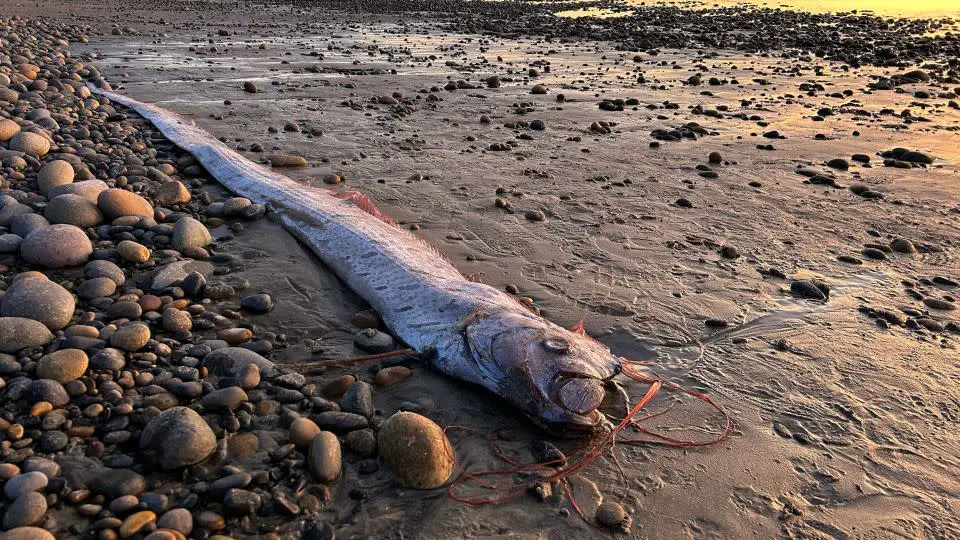Oarfish Sightings Stir Mystical Theories and Scientific Curiosity
For the third time this year, a mysterious deep-sea oarfish has washed ashore in Southern California. Known as a “doomsday fish,” the creature has a mythical reputation for foretelling disasters. The latest specimen, measuring 9 feet, appeared on Grandview Beach in Encinitas earlier this month.
Deep-Sea Creature Raises Questions
The oarfish, rarely seen by humans, is an elusive resident of the mesopelagic zone—nearly 3,000 feet below the ocean surface. Its appearance onshore has sparked both intrigue and superstition.
According to Japanese folklore, oarfish sightings herald earthquakes or tsunamis. A notable example came in 2011 when multiple oarfish appeared along Japan’s coast months before the catastrophic earthquake and tsunami struck. However, scientists argue against this theory, citing a 2019 study that found no correlation between sightings and seismic activity.
Scientific Study in Progress
The Grandview Beach specimen was found on November 6 by Alison Laferriere from the Scripps Institution of Oceanography. It was later transported to the Southwest Fisheries Science Center for preservation and analysis. Ben Frable, manager of the Scripps Marine Vertebrate Collection, explained the importance of the find.
“This specimen will allow us to study the biology, anatomy, and genomics of the species,” Frable said in a statement. Samples were collected before freezing the fish for further research. The goal is to uncover the adaptations that help oarfish survive extreme ocean depths.
Earlier Sightings Sparked Similar Interest
This year alone, two other oarfish were spotted along California’s coast. The first, a 12-foot-long specimen, was found in August near La Jolla Cove. Kayakers and snorkelers discovered it near underwater canyons that bring deep-sea water close to shore. Scientists quickly preserved the fish, noting its excellent condition.
A second oarfish was recovered in September on Huntington Beach. However, this specimen was significantly degraded, limiting its research value. Despite its condition, scientists remain eager to learn more from such rare appearances.
Mystical Symbol or Marine Mystery?
The oarfish’s reputation as a harbinger of doom has fueled speculation for centuries. Theories suggest that tectonic activity before earthquakes could force these deep-sea dwellers into shallow waters. Yet, there is no conclusive scientific evidence supporting this claim.
Instead, researchers attribute strandings to environmental changes. Frable highlighted possible causes, including shifts in ocean currents, red tides, and seasonal weather patterns like Santa Ana winds. He emphasized that many factors could contribute to these events.
A Window Into the Deep Sea
Oarfish sightings provide rare opportunities for scientists to study the mysterious species. The fish’s unique evolutionary traits offer insights into how life thrives in the ocean’s harshest conditions. According to Dahiana Arcila, a marine biologist at Scripps, fresh samples from these creatures can advance genomic research.
“This discovery lets us study the evolutionary adaptations that enable survival in deep-sea environments,” Arcila said.
The recent strandings also add to one of the largest collections of deep-sea fish in the world, housed at Scripps. Each addition contributes to understanding the biology of a largely unexplored marine ecosystem.
A Rare but Recurring Event
Over the past century, oarfish sightings have been sporadic, with only 22 documented cases in California. This year’s frequency—three strandings in as many months—is unusual and has drawn widespread attention. The fish’s size and serpentine appearance, often described as “sea monsters,” add to their allure.
Symbolism Meets Science
The oarfish continues to captivate public imagination, blending folklore with scientific inquiry. While some see its arrival as an ominous sign, others view it as a chance to unravel deep-sea mysteries. As researchers dive deeper into the biology and behavior of this elusive creature, its story straddles the line between myth and discovery.











